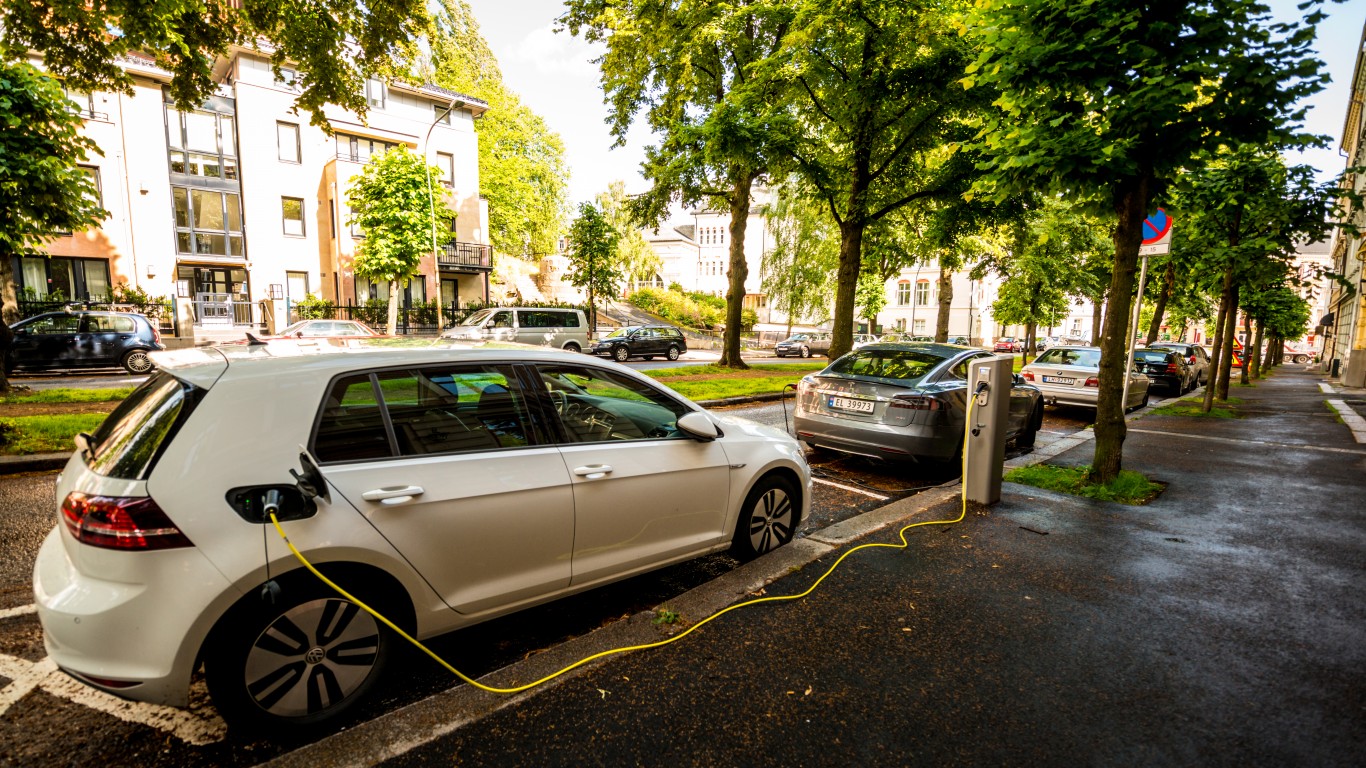Energy
Renewable Energy and Electric Cars Pressure Oil Economically as Well as Environmentally

Published:
Last Updated:

Investing in renewable energy gets a lot of attention for being the “right thing” to do to save the planet from the effects of climate change. Rarely, however, is it praised as a sound economic investment. That could be changing.
BNP Paribas analyst Mark Lewis recently looked at the energy return from a $100 billion investment in both renewables and oil, where the energy output is used specifically for cars and other light-duty vehicles (LDVs) like sport utility vehicles, crossovers and pickup trucks. Lewis calls the concept Energy Return on Capital Invested (EROCI) because it measures how much actual energy gets to the wheels that are driving our LDVs.
Here’s his conclusion: “Our analysis indicates that for the same capital outlay today, new wind and solar-energy projects in tandem with battery electric vehicles (EVs) will produce 6x-7x more useful energy at the wheels than will oil at $60/[barrel] for gasoline-powered LDVs, and 3x-4x more than will oil at $60/[barrel] for LDVs running on diesel.” (EVs are defined as all-electric vehicles, not hybrids, plugin or otherwise.)
There’s even worse news for oil companies: “[W]e calculate that the long-term break-even oil price for gasoline to remain competitive as a source of mobility is $9-$10/[barrel], and for diesel $17-19/ [barrel].” When oil prices drop below $40 a barrel now, most companies cannot make a profit. At $10 a barrel, not even the Saudis or the Russians can make a profit.
How can this be? After all, according to BP’s 2019 Statistical Review, the world has a total of 1.73 trillion barrels of proved oil reserves (that means there’s a 90% chance the oil can be produced at current costs and prices). Assuming that demand levels off at around 100 million barrels a day, those reserves will last nearly 50 years.
To extract those barrels, however, is costly, and the marginal cost of a barrel will rise as the reserves are extracted and new reserves fail completely to replace the pumped oil. Costs rise and prices to consumers follow.
The short-run marginal cost of energy from the sun and wind is zero. It’s like software in that regard. The first megawatt-hour costs millions, perhaps even billions of dollars, but the price declines with every megawatt generated until it reaches essentially zero. A new solar PV farm costs about $1 million per megawatt to construct. China’s Tengger Desert Solar Park has a capacity of 1,447 megawatts and would have cost about $1.5 billion to build. Aside from maintenance and possible expansion, however, there are no further costs associated with the hardware.
According to the BNP Paribas study, a new solar photovoltaic (PV) plant that costs $800 million to build is comparable to oil at $19 a barrel.
Oil, of course, has a built-in advantage: its massive scale. Oil provided a third of the world’s energy last year, more than 10 times the amount provided by solar and wind. There is also the massive global infrastructure for extracting, lifting, shipping and delivering petroleum products. When it comes to LDVs, electric vehicles are more expensive to buy and are likely to remain so for the next five or so years.
Yet, the BNP Paribas study notes, oil’s advantages are time-limited. The need to replenish extracted reserves every year means that barrels that have a break-even cost of more than $20 a barrel may not be developed. As BloombergNEF points out in its 2019 outlook, EV sales are expected to rise from a record 1.1 million worldwide in 2018 to 11 million in 2025, and then surge to 30 million in 2030 as EVs establish cost advantage over internal combustion engine vehicles.
The study estimates that energy from gasoline and diesel fuel for LDVs last year totaled 2,660 terawatt-hours and cost about $1.12 trillion to produce. That represents about a quarter of the total oil market. BNP Paribas calculates that an outlay of $100 billion results in a net EROCI of 240 terawatt-hours of energy.
Over a 25-year period, the cost of that energy totals more than $25 trillion. To match that, onshore wind projects would require a 25-year investment of $3.97 trillion, offshore wind projects would require $3.55 trillion and solar PV would require $3.97 trillion.
The short version of the BNP Paribas study is that oil demand faces a bigger challenge today than ever before in its history. Renewable energy and electric vehicles pose an existential threat to oil due to a big advantage in the short-run marginal cost of energy to wheels, a cleaner environment and easy transportation. With the necessary scale, wind and solar could replace 40% of global demand for oil.
Oil companies are trying to get in front of this threat by proposing a variety of plans, including carbon dividends that are supposed to look like carbon taxes and would be paid by the consumers at the pump and then refunded to those consumers. Spending real money on mitigating the effects of climate change or changing people’s driving habits don’t figure into these plans at all.
Start by taking a quick retirement quiz from SmartAsset that will match you with up to 3 financial advisors that serve your area and beyond in 5 minutes, or less.
Each advisor has been vetted by SmartAsset and is held to a fiduciary standard to act in your best interests.
Here’s how it works:
1. Answer SmartAsset advisor match quiz
2. Review your pre-screened matches at your leisure. Check out the advisors’ profiles.
3. Speak with advisors at no cost to you. Have an introductory call on the phone or introduction in person and choose whom to work with in the future
Thank you for reading! Have some feedback for us?
Contact the 24/7 Wall St. editorial team.